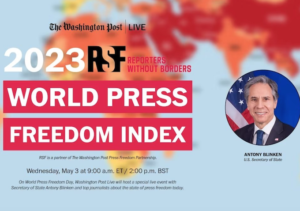Highlights of the 2023 World Press Freedom Index. Video: RSF
By David Robie
Timor-Leste has topped a stunning rise among Asia-Pacific countries to make it to into the “top ten” countries in this year’s World Press Freedom Index that saw island nations improve their rankings.
The youngest nation in Southeast Asia — which gained independence from Indonesia in 2002 — jumped from 17th last year to 10th as the Paris-based global media watchdog Reporters Without Borders (RSF) warned that this year’s survey demonstrated “enormous volatility” because of “growing animosity” towards journalists on social media and in the real world.
The 2023 RSF Index was launched today as Pacific nations marked the 30th anniversary of World Press Freedom Day with editorials, celebrations, seminars and rallies.
- READ MORE: World Press Freedom Index 2023 – journalism threatened by fake news industry
- Other Pacific Media Watch reports

Timor-Leste’s success was hailed after the country had survived many challenges and threats to media freedom in the years following independence with Bob Howarth, a former newspaper executive in Papua New Guinea and editorial adviser and trainer in Dili, said it was partially thanks to a “vibrant media” scene.
The RSF report said that Timor-Leste was “one of this year’s surprises . . . a young democracy still under construction [entering] the Index’s top 10.” It previously had a track record of intimidating the media.
New Zealand, which had previously been a regular country in the top ten list slipped from 11th to 13th. Although the Index did not state why, it is believed that the hostile and threatening atmosphere against the media during last year’s anti-vaccination parliamentary protest contributed.
The Index describes NZ as a “regional press freedom model”.
Samoa rose dramatically 26 places to 19th to place it ahead of Australia. This was probably due to the change of government in the Pacific nation with the country’s first woman prime minister, Fiamē Naomi Mataʻafa, and her FAST party having ousted the authoritarian HRPP government of Tuila’epa Sa’ilele Malielegaoi and ushered in a more consultative relationship with the media.
Australia improves
Australia also improved 12 places to 27th, also thanks to a more relaxed media environment coinciding with a change of government and some positive media freedom moves.
Fiji did even better, rising 13 places to 89th, but should expect to significantly improve on this next year after the new coalition government scrapped the draconian Fiji Media Industry Development Act last month. This hated law was originally a decree imposed after the 2006 military coup and “weaponised” by the FijiFirst government and other recent media freedom initiatives.
However, this step along with other promising media freedom developments happened after the Index cut-off assessment period. The autocratic FijiFirst government was ousted in an election last December.
“Today is World Press Freedom Day,” wrote Fiji Times editor Fred Wesley today in an editorial.
“It is perhaps more significant than ever for journalists in Fiji now that we have the draconian piece of legislation, the MIDA Act repealed.”
Papua New Guinea rose three places to 59th in spite of the Index noting that direct political interference often “threatened editorial freedom at leading media outlets”. The report cited EMTV as an example, where the entire newsroom walked out in protest over the suspension of experienced news director Sincha Dimara in February 2022.
EMTV news team walk out in protest over suspension of their chief editor
Sacked, the journalists started their own online media, Inside PNG, and covered the 2022 general election, which was marred by violence.
Tonga rose five places to 44th although the Index said some political leaders “did not hesitate to go after reporters who embarrass them”.

Welcoming the elevation of Timor-Leste as an example to the Pacific region, media consultant Bob Howarth, a founding member of the Timorese journalists association AJTL, said there were several contributing factors.
Non-stop training
“The country has been running non-stop training for media with support from UNDP and several donor countries, a vibrant media scene including a huge community radio network and a government easily accessible for local journos — remember the Chinese minister [Wang Yi] who ignored media all over the Pacific but had to front in Dili?
“Plus they now host the Dili Dialogue, an annual gathering of Southeast Asian and some Pacific press councils.
“Not a single murder, assault or threat to local journos. And visiting reporters don’t need special visas like in Papua New Guinea.
“Plus Timor-Leste is free of religious or ethnic biases after 25 years of brutal occupation by Indonesia and it has a very active and united journalists’ association.”
In Paris, RSF noted how Norway had topped the Index for the seventh year running.
“But – unusually – a non-Nordic country is ranked second, namely Ireland (up 4 places at 2nd), ahead of Denmark (down 1 place at 3rd),” said the report.
The Netherlands had risen 22 places to 6th – “recovering the position it had in 2021, before [investigative crime reporter] Peter R. de Vries was murdered.”
Bottom of the scale
At the bottom of the scale, China – “the world’s biggest jailer of journalists and exporters of propaganda” – had dropped four places to 179th, just ahead of North Korea, unsurprisingly bottom at 180th.
According to Christophe Deloire, RSF’s secretary-general, “The World Press Freedom Index shows enormous volatility in situations, with major rises and falls and unprecedented changes, such as Brazil’s 18-place rise and Senegal’s 31-place fall.
“This instability is the result of increased aggressiveness on the part of the authorities in many countries and growing animosity towards journalists on social media and in the physical world.”
He also blamed the volatility on the “growth in the fake content industry, which produces and distributes disinformation and provides the tools for manufacturing it”.
Dr David Robie is convenor of Pacific Media Watch and author of Don’t Spoil My Beautiful Face: Media, Mayhem and Human Rights in the Pacific.











































